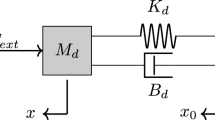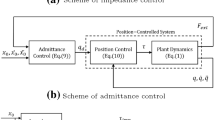Abstract
Impedance Control and Admittance Control are two distinct implementations of the same control goal but their stability and performance characteristics are complementary. Impedance Control is better suited for dynamic interaction with stiff environments and Admittance Control is better suited for interaction with soft environments or operation in free space. In this paper, we use a hybrid systems framework to develop an entire family of controllers that have Impedance Control and Admittance Control at two ends of its spectrum; and intermediate controllers that have stability and performance characteristics that are an interpolation of those of Impedance Control and Admittance Control. The hybrid systems framework provides the scope for maintaining stability and achieving the best performance by choosing a specific controller for a given environment and by continuously changing the controller to adapt to a changing environment. The advantage of our approach is demonstrated with an extensive case study of a one-dimensional system and through experiments with the joint of a lightweight robotic arm.
Similar content being viewed by others
References
Aghili, F.: Robust impedance control of manipulators carrying a heavy payload. J. Dyn. Syst. Meas. Control, 132 (2010)
An, C.H., Hollerbach, J.M.: Dynamic stability issues in force control of manipulators. In: IEEE International Conference on Robotics and Automation, pp. 890–896 (1987)
Anderson, R.J., Spong, M.W.: Hybrid impedance control of robotic manipulators. IEEE Trans. Robot. Autom. 4 (5), 549–556 (1988)
Brogliato, B.: Nonsmooth Mechanics, 2nd edn. Springer (1999)
Carignan, C.R., Smith, J.A.: Manipulator impedance accuracy in position-based impedance control implementations. In: IEEE International Conference on Robotics and Automation, pp 1216–1221 (1994)
Cheng, G., Hyon, S.-H., Morimoto, J., Ude, A., Colvin, G., Scroggin, W., Jacobsen, SC.: Cb: A humanoid research platform for exploring neuroscience. In: HUMANOIDS (2006)
Das, T., Mukherjee, R.: Shared-sensing and control using reversible transducers. IEEE Trans. Control Syst. Tech. 17, 242–248 (2009)
Eppinger, S.D., Seering, W.P.: Understanding bandwidth limitations in robot force control. In: IEEE International Conference on Robotics and Automation, pp. 904–909 (1987)
Ferretti, G., Magnani, G.A., Rocco, P., Cecconello, F., Rossetti, G.: Impedance control for industrial robots. In: IEEE International Conference on Robotics and Automation, pp. 4027–4032 (2000)
Gantmacher, F.R.: The Theory of Matrices, vol. 1, pp. 239–241. Chelsea Publishing (1959)
Hogan, N.: Impedance control: An approach to manipulation, part I - theory. ASME J. Dyn. Syst. Meas. Control 107, 1–7 (1985)
Hogan, N.: Impedance control: An approach to manipulation, part II - implementation. ASME J. Dyn. Syst. Meas. Control 107, 8–16 (1985)
Hogan, N.: Impedance control: An approach to manipulation, part III - applications. ASME J. Dyn. Syst. Meas. Control 107, 17–24 (1985)
Horn, R.A., Johnson, C.R.: Matrix Analysis. Cambridge University Press (1990)
Kang, S.-H., Jin, M., Chang, P.-H.: A solution to the accuracy/robustness dilemma in impedance control. IEEE/ASME Trans. Mechatron. 14 (3), 282–2934 (2009)
Lawrence, D.A.: Impedance control stability properties in common implementations. In: IEEE International Conference on Robotics and Automation, pp. 1185–1190 (1988)
Liberzon, D., Morse, A.S.: Basic problems in stability of switched systems. IEEE Control Syst. Mag., 59–70 (1999)
Liu, G.J., Goldenberg, A.A.: Robust hybrid impedance control of robot manipulators. In: IEEE International Conference on Robotics and Automation, pp. 287–292 (1991)
Lu, W.S., Meng, Q.H.: Impedance control with adaptation for robotic manipulations. IEEE Trans. Robot. Autom. 7, 408–415 (1991)
Mason, M.T.: Compliance and force control for computer controlled manipulators. IEEE Trans. Syst. Man Cybern. 11 (6), 418–432 (1981)
Ott, C., Eiberger, O., Friedl, W., Bäuml, B., Hillenbrand, U., Borst, C., Albu-Schäffer, A., Brunner, B., Hirschmüller, H., Kielhöfer, S., Konietschke, R., Suppa, M., Wimböck, T., Zacharias, F., Hirzinger, G.: A humanoid two-arm system for dexterous manipulation. In: IEEE-RAS International Conference on Humanoid Robots, pp. 276–283 (2006)
Newman, W.S.: Stability and performance limits of interaction controllers. J. Dyn. Syst. Meas. Control 114, 563–570 (1992)
Ott, C., Mukherjee, R., Nakamura, Y.: Unified impedance and admittance control. In: IEEE International Conference on Robotics and Automation, pp. 554–561 (2010)
Pelletier, M., Doyon, M.: On the implementation and performance of impedance control on position controlled robots. In: IEEE International Conference on Robotics and Automation, pp. 1228–1233 (1994)
Raibert, M.H., Craig, J.J.: Hybrid position/force control of manipulators. ASME J. Dyn. Syst. Meas. Control 105, 126–133 (1981)
Roy, J., Whitcomb, LL.: Adaptive force control of position/velocity controlled robots: Theory and experiment. IEEE Trans. Robot. Autom. 18 (2), 121–137 (2002)
Salisbury, J.K.: Active stiffness control of a manipulator in cartesian coordinates. In: Proceedings of the IEEE Conference on Decision and Control, pp. 383–388 (1980)
Seraji, H.: Adaptive admittance control: An approach to explicit force control in compliant motion. In: IEEE International Conference on Robotics and Automation, pp. 2705–2712 (1994)
Siciliano, B., Khatib, O. (eds.): Handbook of Robotics. Springer, Berlin / Heidelberg (2008)
Slotine, J.-J.E., Li, W.: Adaptive manipulator control: A case study. In: IEEE International Conference on Robotics and Automation, pp. 1392–1400 (1987)
Surdilovic, D., Kirchhof, J.: A new position based force/impedance control for industrial robots. In: IEEE International Conference on Robotics and Automation, pp. 629–634 (1996)
Valency, T., Zacksenhouse, M.: Accuracy/robustness dilemma in impedance control. ASME J. Dyn. Syst. Meas. Control 125, 310–319 (2003)
Author information
Authors and Affiliations
Corresponding author
Rights and permissions
About this article
Cite this article
Ott, C., Mukherjee, R. & Nakamura, Y. A Hybrid System Framework for Unified Impedance and Admittance Control. J Intell Robot Syst 78, 359–375 (2015). https://doi.org/10.1007/s10846-014-0082-1
Received:
Accepted:
Published:
Issue Date:
DOI: https://doi.org/10.1007/s10846-014-0082-1




